| Home>Myth>Article |
AmenoToyoTarashiKaraHime and The Eight-Colored Stone
The following text is a slightly modified machine translation and may have some unnatural parts.
==Introduction==
There is a shrine called Ishi-gami Shrine in Tono-town, Hamada City, Shimane Prefecture. The official name is AmenoToyoTarashiKaraHime-no-mikoto Shrine, and the deity is the goddess AmenoToyoTarashiKaraHime, who pioneered Iwami and bestowed clothing and food. Locally, it is called "Iwagami-san". "Ishigami" means the goddess of stone. and "Iwagami" means the goddesse of rock.
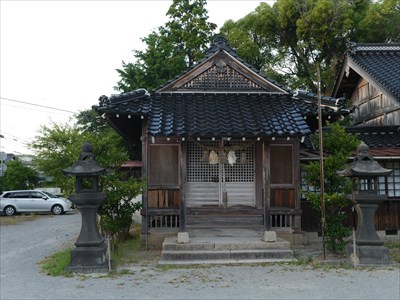
Ishigami Shrine
"Toyo Tarashi" means to fill with abundance. There is a theory that "kara" means "唐" and "韓", which means foreign countries, and that it is a misprint of "栖".
In addition, it is not clear whether this Iwami is the country of Iwami or Iwami Township (Hamada River basin).
There is a stone monument in the shrine precincts, showing the history of the shrine. The original text is difficult to read, but there is a commentary on the inscription on the side. According to the story, it is unfounded and unbelievable that God turned into a rock." There seems to be a legend that the goddess turned into a rock, but the details are not clear. When I looked it up, this legend was about the Tatsuiwa Shrine in Yairoishi, Ochi-gun.
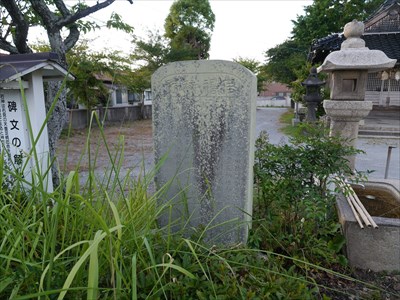
Stone Monument about History of Ishigami Shrine
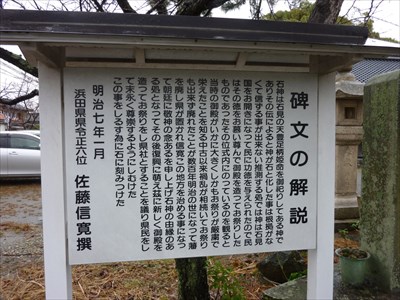
History of Ishigami Shrine
I don't know when, but there is a rock that makes a haunting, and there is a legend that when the god cut the rock, the haunting stopped, and that legend evolved and It became a legend that the goddess appeared and turned into a rock. In the Taisho era, it developed further, and the legend became a brave plot to subdue the snake that turned from rock by the goddess herself.
==Legend of Yairoishi==
There is a treatise entitled "About Ishigami distributed to Iwami region" by Takatoshi Chiyonobu, which was published in a prewar magazine called "Shimane Criticism", which comprehensively summarizes the belief about Ishigami in the Iwami region of Shimane prefecture.
The history of Tatsuiwa Shrine says "Excerpt of ancient affairs (Koji-Basui)", and the legend of the goddess is recorded. The "excerpt of ancient affairs" is probably "excerpt of ancient affairs of Hamada". I haven't read it directly in "excerpt of ancient affairs of Hamada (Hamada Koji Bassui)", but the legend is reprinted in "Iwami Kaitei no Ikuri", which written by Dokusuien Dokusei.
According to it, when YatsukaMizunoOmiTsunu (the god who appears in Izumo Fudoki) descended from heaven, the trees in the mountains of Iwami country died and the river dried up due to Yairoishi (the eight-colored stone). A goddess (AmenoToyotarashiKaraHime) told him that the stone turned into a big snake and bothered the people. YatsukaMizunoOmiTsunu wanted to destroy this for the sake of the country and the people, so he went with the guidance of goddess and cut the Yairoishi in two tiers. Then the neck flew to become a Tatsuiwa (dragon rock) in Ochi-County, and the tail became a Tsunoishi (square stone) in Mino-County. The goddess was delighted that the disaster was gone and welcomed YatsukaMizunoOmiTsunu. He couldn't deny it and settled in the hermitage, but at dawn the goddess suddenly became a rock. He was skeptical and said that he had seen a mysterious rock ...
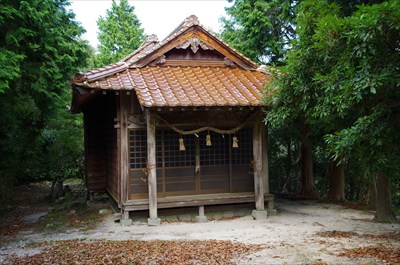
Tatsuiwa Shrine
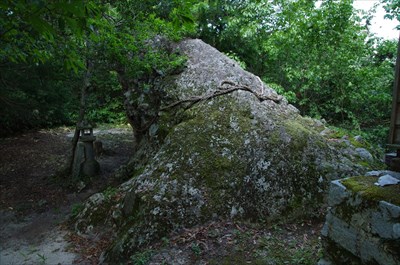
Tatsuiwa Rock
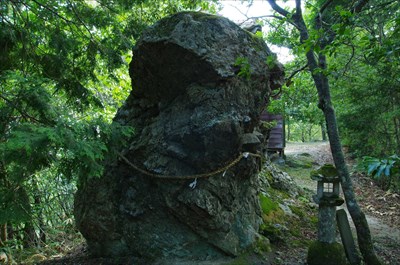
Tatsuiwa Rock
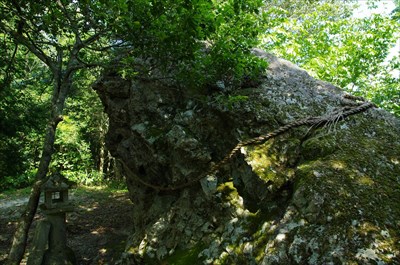
Tatsuiwa Rock
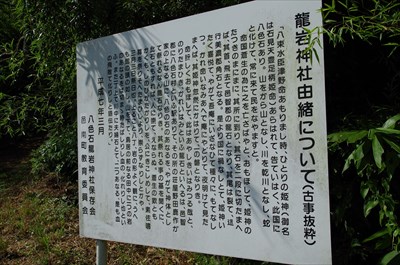
Excerpt of ancient affairs
It is probably a place name narrative with "Iwamitsurukana (had seen a rock)" as the etymology of Iwami. In the olden days, it was called Iwami AmenoToyotarashiKaraHime-no-mikoto Shrine, so there is a theory that the name of the goddess is the etymology of Iwami.
In the latter part of the history of Tatsuiwa Shrine,
Ryuseki (dragon stone) is located in Yashiroishi Village in Ochi-County, and it is Tatsuiwa that enshrines the Yashiroishi (eight-colored stone) in the back mountain of the house of Shikasaku Noda, which is the village headman, as a god. When They hear the origin of worship, They doesn't like this stone because it is cursed by people. The officials heard that the people's mourning was difficult to endure, and when Susanoo was enshrined, the stones were no longer cursed...
In other words, there was a haunting stone on the mountain behind the mansion of village headman, and when he was worshiping Susanoo, the curse stopped. In other words, this is the prototype of the legend of the goddess.
In "Iwami Kaitei no Ikuri," the latter part states as follows.
Roughly translated ... As for the fact that it was cut into three tiers, an excellent person said that in the three tiers, there was a tradition of the tail and neck, but no body tradition. It is said that there is a curse rock in Hamada Castle that is always cursed when a person touches it. Is this a ghost of that body? According to Mr. Furuta, while this castle was built, there was no way for people to curse, but after building a shrine pillar and cleansing themselves and worshiping it, the curse stopped. However, at that time, ancient studies (Confucianism) had not been deepend at all, so people were just afraid of haunting and did not know such ancient so-called. It's dull. Besides, the worshiper is also a Zen temple called Kanon-ji. This is also not the original purpose.
It seems that Hamada Castle also had a legend of haunting rock. I haven't seen it, but it seems that there is a rock related to Ishigami on the site of Hamada Castle.
==Iwami Yae Mugura==
This legend is also featured in the Edo period geography book "Iwami Yae Mugura".
Another theory is that the descendants of Yamata-no-Orochi from Izumo appeared in Shinto Village, Ochi-County. The mountain becomes a dead mountain and the river dries up and afflicts the people, so Onamuchi (Okuninushi) cut it in three tiers. The head flew to Yashiroishi-mura, Ochi-County, and afflicted people and horses. Therefore, the villagers worshiped Susanoo and calmed it down. This becomes an Yairosihi (eight-colored stone), which is enshrined with Susanoo, and is said to be Yairoishi Daimyojin, according to the old man's biography. From here, We started to call it Iwami ....
This is associated with the Yamata-no-Orochi myth. There is no description here that the goddess turned into a rock. It can be said that the ending that the goddess turned into a rock was inserted later.
==Naka-County Magazine==
To summarize the content published in Ikutaro Oshima's "Naka-County Magazine", the country of Iwami was pioneered by AmenoToyotarashiKaraHime and was abundantly satisfied. The people were enjoying peace as if to beat their bellies, but at that time a raging god appeared and responded to the east and west, turning into a long swelling snake and attacking Iwami. In the urgent autumn, AmenoToyotarashiKaraHime received the help of Izumo's YatsukaMizunoOmiTsunu, and greeted him, cutting the snake into three tiers and destroying them. That night, when a feast was held for her labor, AmenoToyotarashiKaraHime died and became a rock. They say that even though the princess has passed away, her achievements will be rock solid ...
When it went down to the Taisho era (1912-1926) when "Naka-County Magazine" was written, it became a brave story that the princess exterminates the dragon, probably according to the temper of Iwami.
==Kagura==
This legend has been taken up as a creation Kagura, and in the performance "Ishigami" in the Matsubara company in Misumi-town, Hamada city, the princess died when she was hit by the miasma of a large snake, and it turned into a rock to watch over Iwami.
==Hamada Kagami==
Muneo Fujii, a national scholar from Hamada City, was active in the Meiji era, and wrote in his "Hamada Kagami" as follows.
Ishigami behind the shrine was a mysterious stone when it was a nation of Anato 5,000 years ago, and Kadota appealed to YatsukaMizunoOmiTsunu, so he ordered Amado and Kumado to defeat it. They broke the stone into eight tiers, so the place is called Iwami. The stone is still there. The sound of the Amado is similar to that of Hamada ....
Some of the names of gods are different in "Hamada Kagami".
==Consideration==
From the above, I don't know when it was, but there is a legend that there was a haunting rock, and when the god cut the rock, the haunting stopped, which is probably the prototype of the legend of Yairoishi. As the legend evolved, the rock became a big snake, and in addition, a goddess appeared, and as the times went down, the goddess herself embarked on the snake subjugation. As the times go by, it becomes a brave plot. Aside from dating back to the early Edo period, it cannot be said that there was such a stone legend from the time the shrine was built. It may be possible to think that haunting is the work of the goddess's rough soul.
==Ishigami Shrine==
AmenoToyoTarashiKaraHime-no-Mikoto Shrine is a Shikinai Shrine (the old and officially certified shrines), but it was restored to its current form in the Meiji era after it had declined since the Middle Ages. When I read "Iwami Yae Mugura", it seems that it was in the mansion of the feudal retainer during the Hamada domain.
Muneo Fujii describes the AmenoToyoTarashiKaraHime-no-Mikoto shrine as a shrine related to the Omatsuri AmenoIwatoHiko Shrine (Sanqu Shrine). AmenoToyoTarashiKaraHime-no-Mikoto Shrine is also known as the Omatsuri AmenoIwatoHiko Shrine and Taimasan Shrine.
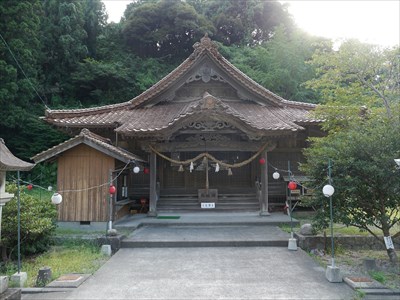
AmenoIwatoHiko Shrine
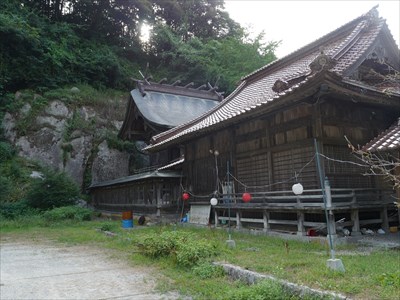
AmenoIwatoHiko Shrine

History of AmenoIwatoHiko Shrine
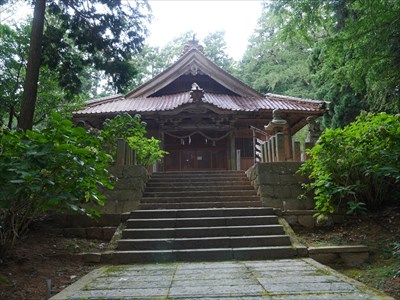
Taimasan Shrine
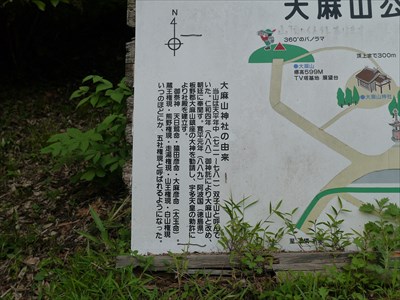
History of Taimasan Shrine
==Who is AmenoToyoTarashiKaraHime?==
According to materials from the Edo period, there is a theory that AmenoToyotarashiKaraHime is interpreted as Yosotarashihime. Yosotarashihime is the mother of AmaTarashiHikoKunioshiHito. AmaTarashiHikoKunioshiHito is the deity of Ikan Shrine in Shimokou-town, Hamada City. In addition, AmaTarashiHikoKunioshiHito is the ancestor of the Kasuga tribe and Kushiro and Ono tribes ranged in Kausga tribe genealogy. Shrines enshrining Kasuga's ancestral spirits are distributed in the Iwami region. From these things, the interpretation that compares AmenoToyotarashiKaraHime to Yosotarashihime was born.
However, Muneo Fujii has stated that he does not take the theory that the goddess is a Yosotarashihime. The Omatsuri AmenoIwatoHiko Shrine and Taimasan Shrine are shrines related to the Inbe tribe, so it may be from there.
There is a popular theory that AmenoToyotarahiKaraHime is the queen goddess of AmenoIwatoHiko, the deity of the AmenoIwatoHiko Shrine. I like the theory.
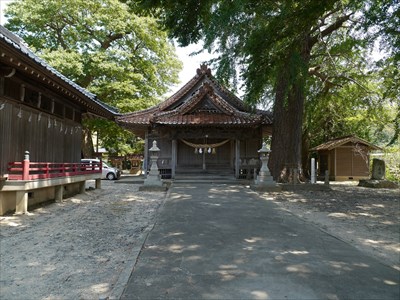
Ikan Shrine
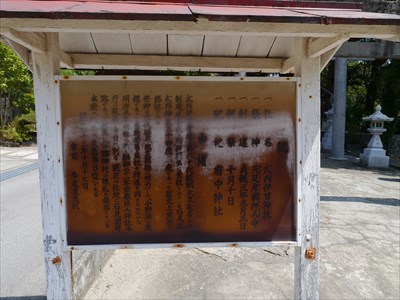
History of Ikan Shrine
==Sandai Jitsuroku==
In 874, there was a description about Ishigami in the section of Emperor Seiwa, Nihon Sandai Jitsuroku (The True History of Three Reigns of Japan), which translates to "Iwami Province stated that two Ishigami came from the Izumo Province. There is also a theory that this Ishigami is interpreted as AmenoToyotarashiKaraHime.
==Former Shimane Prefecture History==
In the history of the former Shimane prefecture, it is paraphrazed as "Ishigami is, after all, just a reidai (substitute worshipped for soul of God) of one generation, and the deity is AmenoToyotarashiKaraHime." AmenoToyotarashiKaraHime is probably called AmenoToyotarashiKaraHime.
==Mizoorihime==
According to the article of Ikan Shrine of "Iwami Yae Mugura", one of the deities is Mizoorihime, and the goddess is the younger sister of AmenoToyotarashiKaraHime. In "History of Naka-County" by Ikutaro Oshima, Mizoorihime is referred to as TsumatsuHime, and is the goddess of weaving. TsumatsuHime is the daughter of Susanoo and appears with OyaHime.
Kunio Yanagita, a Japanese folklorist, interpreted the weaving goddess as a shrine maiden who sewed the garment of God, and that the shrine maiden was also the wife of God.
==Conclusion==
The name of the goddess has the idea of calming and reconciling the conflict by bringing fertility and satisfying it, which may be island-like, but it may be the basis.
==Digression==
The commentary on the inscription at Ishigami Shrine says "復興に萌え (Moe for reconstruction)", This is the oldest example of modern usage of "萌え(Moe)" ... it's a joke, and it's a nuance occurred to the heart. The inscription says "可興復 (to reconstruct)" and does not have the character "萌 (Moe)".
When I returned home in August 2008, I visited the Shimane Prefectural Library in Matsue. And I actually read "Shimane Criticism". Regarding "About Ishigami distributed to Iwami region", Expectation proved right. The legend of AmenoToyotarashiKaraHime was written. Then, I was able to reach the information on Tatsuiwa Shrine in Yairoishi, Onan-Town, Ochi-County, and the printed "Iwami Kaitei no Ikuri". "About Ishigami distributed to Iwami region" is a prewar treatise, so for the first time in decades, Ishigami shrine in Hamada City and the Tatsuiwa Shrine in Onan Town were connected by legend.
I visited Tatsuiwa Shrine in the August 2008. There were more than 400 stairs, and it was raining that day, so I couldn't sit down and rest, and my legs hurt. It went up about 80 meters at a stretch.
I was clinging to a big insect, maybe a bee. I had an umbrella, so I prevented it.
I didn't notice it when I visited, but it seems that spring water is coming out from the back of the shrine. There was a frog far above the stairs, so I wondered how it came up near the summit, but there was spring water.
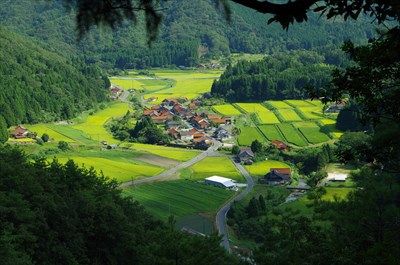
Yairoishi district
==References==
- *千代延尚壽「石見に頒布せる石神について」『島根評論 第4巻上 第6号(通巻第33号)』(島根評論社, 1936)pp.2-13
- *独酔園独醒「石見海底の伊久里」『石見国名所和歌集成』(工藤忠孝/編, 石見地方未刊資料研究会, 1977)
- *『那賀郡誌(復刻版)』(那賀郡共進会展覽会協賛會/編, 臨川書店, 1986)pp.65-74
- *『那賀郡史』(大島幾太郎, 大島韓太郎, 1970)pp.120-121
- *『角鄣経石見八重葎』(編集・発行者 石見地方未刊行資料刊行会, 1999)
- *『濱田鑑』(藤井宗雄, 安達共栄堂, 1905)pp.7-8
- * 藤井宗雄「石見国式内神社在所考」『神祇全書 第5輯』(思文閣, 1971)
- *『國史大系 第4巻 日本三代實録』(黒板勝美/編, 吉川弘文館, 2000)
- *『島根縣史 第2巻(国造政治時代)』(島根県史編纂掛/編, 名著出版, 1972)
- *『桃太郎の誕生』(柳田国男, 角川書店, 1974)